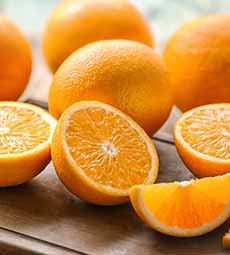Orange Shortbread Bars Recipe For National Citrus Month
|
|
January is National Citrus Month, traditionally a time when oranges and lemons appear in more recipes—like this Orange Shortbread Bars recipe from Fruits From Chile. In the cold months, when most fruits don’t grow in the U.S., Chile is a source of apples, apricots, avocados, blueberries, cherimoya, cherries, citrus, figs, grapes, kiwifruit, lucuma, nectarines, papaya, peaches, pears, plums, pomegranates, and raspberries. This recipe uses Chilean navel oranges. > The history of navel oranges is below. Cook time is 30-35 minutes for the shortbread crust, and an additional 30-40 minutes once the filling is added. Chilling time is 1 hour. For The Shortbread Crust 1. PREHEAT the oven to 325°F. Thoroughly butter a 9×13 inch glass baking pan. 2. MAKE the shortbread crust. In a large mixing bowl, stir together the flour and sugar. Add the slices of butter and orange zest. 3. USING a pastry cutter or two knives, cut butter into the flour until you have a coarse crumb. Transfer the dough to your buttered baking dish. Use your fingers to press the crust pan. Transfer to the preheated oven. While the shortbread is baking… 4. PREPARE the citrus filling. Stir together the flour and sugar in a medium mixing bowl. Add the eggs, orange juice and zest, then whisk thoroughly to combine. 5. BAKE the shortbread for 30-35 minutes, or until golden at the edges. Remove the pan from the oven and let cool for 15 minutes. Then pour the citrus filling onto the partially-baked crust. 6. RETURN the pan to the oven and bake for 30-40 minutes, or until the topping is set—when you jostle the pan, the liquid should jiggle a bit, but not run. 7. LET the pan sit on a rack until cooled to room temp. Then chill in the refrigerator for 1 hour, allowing the bars to be fully set. 8. TOP the bars with a light dusting of powdered sugar. Slice and enjoy. The appearance of the navel is the result of a mutation that created a conjoined twin, an aborted second orange at the opposite end of the stem. It looks like a human navel but is in fact a small, second orange. It first appeared on a single branch on a sour orange tree in the garden of a monastery in Bahia, Brazil. There but for chance it might still be, unknown. But a Presbyterian missionary came upon it in the mid-1800s. It was intriguing to find an orange with a belly button and a baby orange inside. But more importantly, it was sweet and had no seeds. |
|
|
Because the mutant navel orange was seedless, all of the navel oranges that followed are genetically identical to the original orange. A seedless orange has no way to reproduce naturally, so a nurseryman has to graft sprouted buds onto another tree’s trunk and roots. The missionary took a cutting, propagated some little trees, and sent them to William Saunders at the USDA in Washington. Navel Oranges Come To America Saunders had a neighbor named Eliza Tibbets who headed west to the new Riverside Colony in California around 1872. It had the Mediterranean climate that was great for citrus, and Tibbets joined others in growing subtropical fruits. Saunders sent his former neighbor two or three little starter trees that thrived and grew to maturity. Fruits from those trees won a citrus fair in the Riverside area, and were declared the most spectacular citrus fruit anyone had ever seen or ever tasted. And thus, was the beginning of what became the immensely successful commercial navel orange industry in California. One of Tibbets’ two trees still stands and bears fruit, at the corner of Magnolia and Arlington in the middle of Riverside. Its roots have been swapped out, and its old-age fruit is small these days, but it still holds quite a story [source]. |
||



